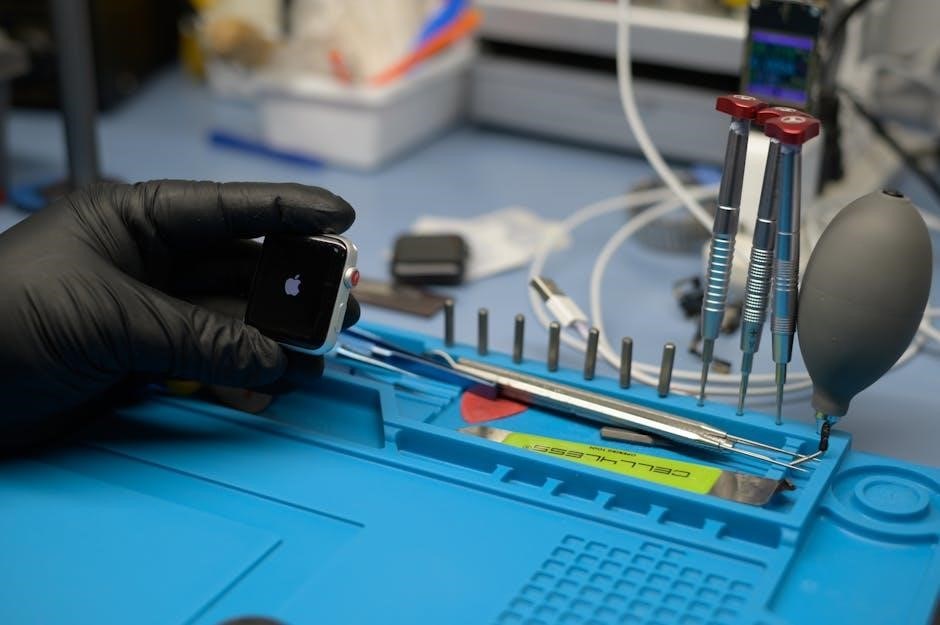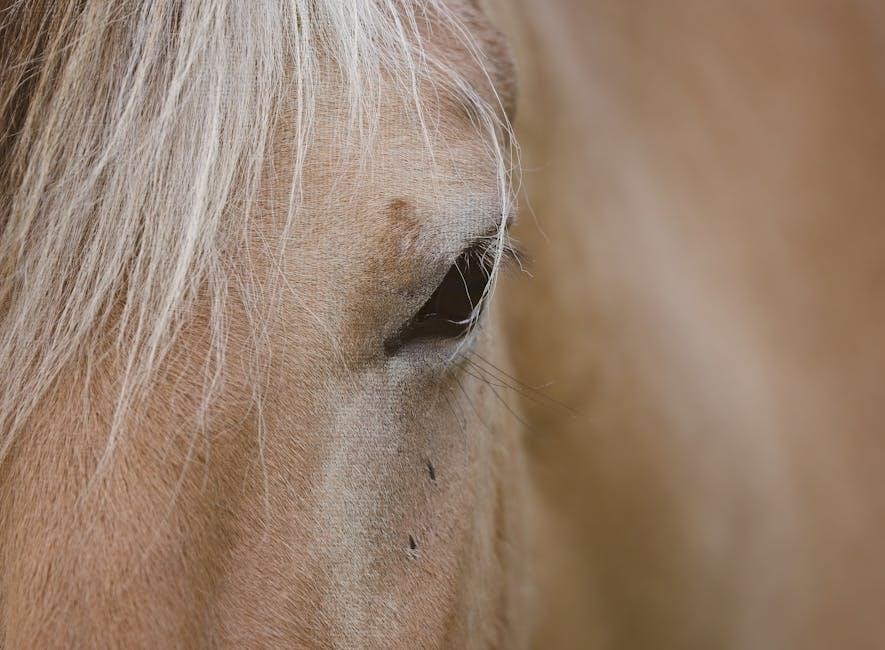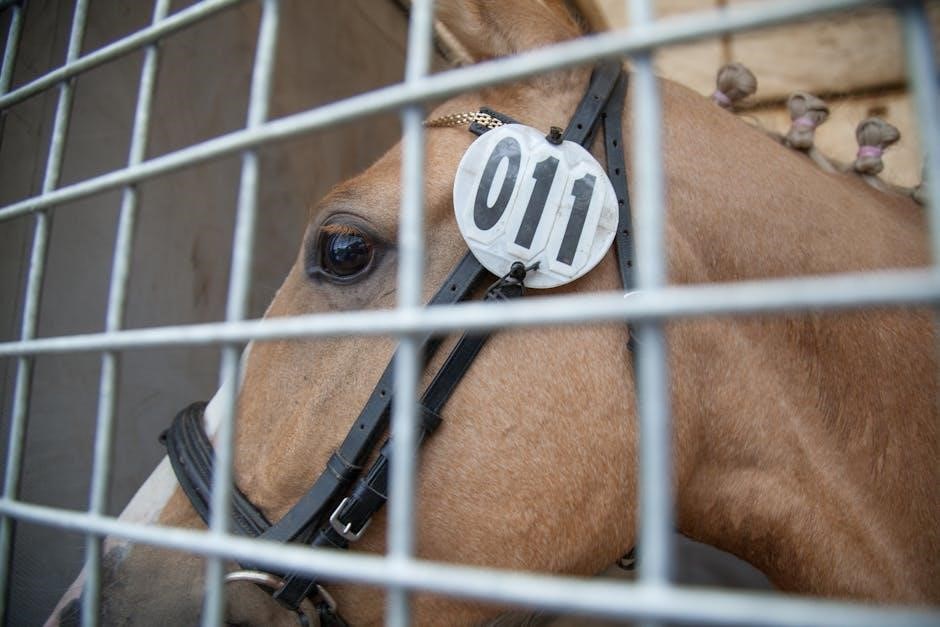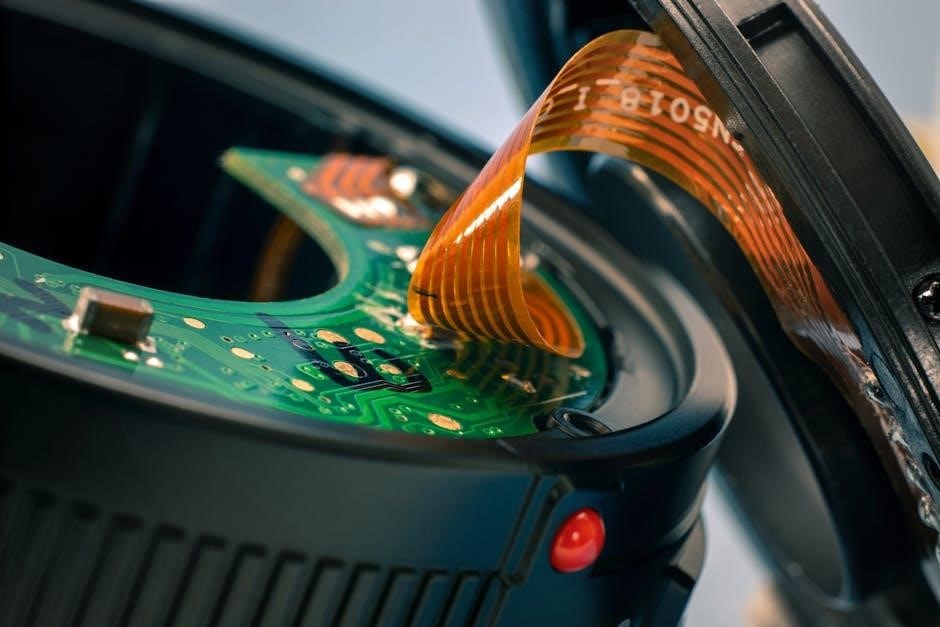The Colt 1911 is a legendary firearm with a rich history, known for its reliability and durability. Disassembly and reassembly are essential skills for owners, enabling proper maintenance, repair, and customization; This guide provides a detailed, step-by-step approach to ensure a thorough understanding of the process, helping enthusiasts master the intricacies of this iconic pistol.
1.1 Historical Overview of the Colt 1911
The Colt 1911, designed by John Browning, has been a cornerstone of firearms history since its adoption by the U;S. military in 1911. Initially chambered in .45 ACP, it became renowned for its reliability and stopping power. Over the decades, the 1911 evolved, with the M1911A1 variant introduced in 1924. Its widespread use in both World Wars solidified its legacy. Civilian models, like the Gold Cup, gained popularity among competitors and collectors. Today, the Colt 1911 remains a symbol of innovation, with modern iterations continuing to influence pistol design. Its enduring appeal lies in its timeless blend of functionality and craftsmanship.
1.2 Importance of Proper Disassembly and Reassembly
Proper disassembly and reassembly of the Colt 1911 are critical for ensuring safety, functionality, and longevity. Improper handling can lead to accidental discharges or damage to internal components. Regular maintenance, such as cleaning and lubricating, requires disassembly to access key parts like the barrel, slide, and frame. Additionally, understanding the process allows owners to customize their firearm by installing aftermarket parts. Mastery of these skills enhances safety, reliability, and performance, making it essential for both novice and experienced enthusiasts to follow precise, step-by-step instructions when working with this iconic pistol.
1.3 Safety Precautions and Best Practices

Always ensure the Colt 1911 is unloaded before starting disassembly. Remove the magazine and visually inspect the chamber to confirm it’s empty. Wear safety glasses and work in a well-lit, clean environment. Use proper tools to avoid damaging components or causing accidental discharges. Keep loose parts organized to prevent loss. Never force parts together, as this can cause breakage. If unsure about a step, consult a manual or seek expert guidance. Handle the firearm with care, avoiding unintentional trigger activation. Maintain focus and patience throughout the process to ensure safety and accuracy. Proper safety practices are paramount when working with firearms.

Tools and Materials Required
Essential tools include a barrel bushing wrench, slide stop, and punch set. Specialized tools like a sear staking tool may be needed. Keep lubricants and cleaning supplies handy for maintenance and reassembly. Proper materials ensure a smooth and safe process. Detailed tool lists are provided in subsequent sections for clarity and ease of preparation. Gather all items beforehand to avoid delays during disassembly or reassembly. Organize tools to prevent loss and ensure efficiency when working on your Colt 1911. Safety and organization are key to a successful process. Always use high-quality tools to maintain precision. A clean workspace is crucial for handling small parts. Reference specific tool requirements in dedicated chapters for detailed guidance. Ensure all materials are compatible with the firearm’s finish to prevent damage. Proper preparation enhances both safety and effectiveness. Familiarize yourself with each tool’s purpose to avoid misuse. Avoid using improvised tools, as they can damage components. Keep a parts tray or magnetic mat to keep track of small components. Use a torque wrench for specific bolts to prevent over-tightening. Apply lubricants sparingly to avoid attracting dirt. Always follow manufacturer recommendations for cleaning agents and lubricants. Maintain a well-lit workspace to ensure visibility of small parts. Use protective eyewear when handling springs or other potentially flying components. Keep a parts catalog or manual nearby for reference. Ensure all tools are in good condition to prevent rounding screws or damaging finishes. Store tools and materials in a dry, secure location to prevent rust or loss. Regularly inspect tools for wear and replace as necessary. Utilize a cleaning solvent appropriate for firearms to avoid damaging finishes. Apply a thin layer of rust-inhibiting oil to metal parts after cleaning. Use a soft-bristle brush to remove debris without scratching surfaces. Keep a microfiber cloth handy to wipe down parts. Maintain a log of maintenance activities for record-keeping. Dispose of used materials responsibly to avoid environmental harm. Always follow local regulations when disposing of cleaning agents. Keep a first aid kit nearby in case of accidents. Ensure good ventilation when using chemicals to prevent inhalation. Avoid eating or drinking while working on the firearm. Wash hands thoroughly after handling cleaning agents. Teach others about safety practices if working in a group. Regularly review safety protocols to ensure compliance. Stay updated on best practices through forums or professional resources. Attend workshops or online courses to enhance skills. Join a community of enthusiasts for troubleshooting and advice. Document personal modifications for future reference. Keep track of warranty information if applicable. Understand local laws regarding firearm modifications. Ensure all modifications comply with legal standards. Test the firearm safely after reassembly to confirm functionality. Incrementally reassemble and test subsystems to identify issues early. Use a shooting rest or bench for post-reassembly testing. Keep a log of performance after maintenance to monitor reliability. Record patterns or groupings to assess accuracy improvements. Share experiences and tips with fellow enthusiasts to contribute to the community. Stay humble and open to learning from more experienced individuals. Celebrate successes and learn from setbacks to continually improve. Remember, safety is a continuous process that requires constant vigilance. Never compromise on safety for convenience or speed. Prioritize quality over cost when selecting tools and materials. Invest in durable tools to ensure longevity. Budget accordingly to avoid cutting corners on essential items. Plan ahead to ensure all necessary tools are available before starting. Avoid starting the process if unprepared to minimize risks. Stay focused and avoid distractions while working on the firearm. Use checklists to keep track of steps and ensure nothing is overlooked. Double-check each action to prevent mistakes. Test each function incrementally during reassembly to catch issues early. Seek professional help if confidence is lacking in any step. Confidence comes from knowledge and practice, so take the time to learn. Familiarize yourself with the firearm’s mechanics through study and hands-on practice. Use online resources like forums and videos to supplement knowledge. Print or save important guides for easy access during the process. Highlight or bookmark critical steps for quick reference. Use sticky notes to remind yourself of specific tips or precautions. Maintain a clean and organized workspace to reduce stress and improve efficiency. Play calming music or podcasts to maintain focus and composure. Take regular breaks to avoid fatigue and maintain precision. Set realistic time goals to avoid rushing. Prioritize quality of work over speed. Be patient with yourself, especially if new to the process. Celebrate small victories to stay motivated. Share the experience with friends or like-minded individuals to build camaraderie. Take pride in the work knowing it enhances the firearm’s performance and longevity. Keep the firearm clean and well-maintained to ensure reliability. Regular maintenance is key to preventing malfunctions. Stay proactive in addressing wear and tear. Use the process as an opportunity to inspect and upgrade components. Consider professional inspection if unsure about any aspect. Invest in quality replacement parts to maintain performance. Avoid using substandard parts to prevent reliability issues. Keep original parts for potential future use or resale. Document upgrades for warranty and value purposes. Research parts compatibility to ensure proper fitment. Read reviews or seek recommendations before purchasing. Contact manufacturers for clarification on part specifications. Ensure all upgrades comply with local laws and regulations. Test upgraded components thoroughly before relying on the firearm. Keep a spare set of essential parts for emergencies. Store spare parts securely to prevent loss or theft. Regularly inspect spare parts for condition and functionality. Maintain a maintenance schedule to stay on track. Use a calendar or app to set reminders for periodic checks. Involve a trusted friend or family member in the process for accountability. Teach others the importance of firearm maintenance for safety. Pass on knowledge to the next generation. Keep the process enjoyable by embracing the learning curve. Find satisfaction in completing the task successfully. Remember, a well-maintained firearm is a reliable companion. Take responsibility for its care to ensure it remains functional. Honor the legacy of the Colt 1911 by treating it with respect. Admire the engineering and craftsmanship that goes into this iconic design. Appreciate the opportunity to work on such a historic firearm. Use the process to deepen your appreciation for its mechanics and history. Share your respect and knowledge with others to preserve its legacy. Ensure the Colt 1911 remains in good condition for future use. Pass it down responsibly to ensure its continued service. Keep it in a safe and secure location when not in use. Teach others about firearm safety and responsibility. Lead by example in maintaining and handling the Colt 1911. Stay informed about advancements in firearm technology and maintenance. Adapt proven techniques to improve your process. Stay open to new tools and methods that enhance safety and efficiency. Evolve your skills with the ever-changing landscape of firearm maintenance. Embrace challenges as opportunities to grow and improve. Remember, every step in the process is a chance to enhance your expertise. Approach each task with a mindset of continuous improvement; Strive for perfection in every detail, no matter how small. Take pride in every aspect of the disassembly and reassembly process. Know that your efforts directly impact the firearm’s performance and reliability. Make safety and quality your top priorities throughout the entire process. Dedication to these principles ensures a successful outcome and a dependable firearm.
2.1 Essential Tools for Disassembly
To disassemble the Colt 1911 effectively, you’ll need specific tools. A barrel bushing wrench is crucial for removing the barrel bushing. A slide stop tool aids in releasing the slide. A punch set, with various sizes, is necessary for pushing out frame pins. While a sear staking tool isn’t essential for basic disassembly, it’s useful for advanced work. A flathead screwdriver and rubber-tipped pliers can assist with screws and small parts. Use a magnetic tray to keep components organized. Ensure your workspace is clean and well-lit for visibility. Always handle the firearm safely, even when unloaded. Gather all tools beforehand to streamline the process and avoid delays. Stay organized and cautious to prevent damage or loss of parts.
2.2 Specialized Tools for Reassembly
Reassembling the Colt 1911 requires specialized tools to ensure precision and safety. A sear staking tool is essential for properly securing the sear and disconnector. A trigger pull gauge helps maintain consistent trigger tension. A bushing wrench is necessary for reinstalling the barrel bushing. A sight pusher may be needed if adjusting or reinstalling sights. Additionally, a specialized punch set ensures frame pins are securely aligned. For the firing pin, a firing pin stop tool prevents damage during reinstallation. Use a recoil spring plug to compress the spring safely. These tools are vital for accurate and efficient reassembly, ensuring the firearm functions reliably after maintenance. Always use high-quality tools to avoid marring components.
2.3 Recommended Materials for Maintenance
Proper maintenance of the Colt 1911 requires specific materials to ensure longevity and functionality. High-quality gun oil is essential for lubricating moving parts, while a solvent like Hoppes No. 9 is ideal for cleaning residue. A soft, lint-free cloth prevents scratching during wiping. A nylon or brass-bristle brush helps remove stubborn debris from crevices. Silicone-based lubricant is recommended for the slide rails and trigger components. Additionally, protective gloves and safety glasses should be worn to prevent injury. For rust prevention, apply a thin layer of gun wax or a rust-inhibiting coating. Always use materials specifically designed for firearms to maintain their finish and performance.

Step-by-Step Disassembly Guide
Begin by removing the magazine and ensuring the chamber is clear. Use a barrel tool to depress the barrel lug, allowing the slide to slide off the frame. Carefully disengage the barrel from the slide, then remove the recoil spring and guide rod. Gently pry the frame’s grip screws to access internal components. Use a punch to remove the pins holding the trigger and sear in place. Proceed methodically to avoid losing small parts, ensuring each piece is set aside safely for reassembly.
3.1 Removing the Magazine and Clearing the Chamber
Start by ensuring the Colt 1911 is unloaded. Remove the magazine by pressing the magazine release button, located on the right side of the frame. Once the magazine is removed, rack the slide to the rear to eject any round in the chamber. Visually inspect the chamber to confirm it is empty. Double-check by looking through the ejection port and into the barrel. If any rounds are present, repeat the process until the chamber is clear. This step is critical for safety and ensures no live ammunition is present during disassembly.
For added assurance, use a bore light to illuminate the barrel and chamber, verifying there are no obstructions or remaining rounds. Only after confirming the firearm is unloaded should you proceed with further disassembly.
3.2 Disassembling the Slide and Barrel
To disassemble the slide and barrel, begin by removing the recoil spring and guide rod. Use a bushing wrench to rotate the barrel bushing clockwise, loosening it from the slide. Once loosened, carefully lift the barrel bushing and remove it. Next, slide the barrel out of the front of the barrel bushing. Be cautious, as the barrel may be tightly fitted. After removing the barrel, separate the slide from the frame by sliding it forward. This step requires precision to avoid damaging the components. Always use the correct tools to ensure safe and effective disassembly.
Inspect the barrel and slide for wear or debris before proceeding with further maintenance or reassembly.
3.3 Breaking Down the Frame and Internal Components
After removing the slide, focus on the frame. Take out the trigger, mainspring housing, and grip screws using appropriate tools. Gently pry the mainspring housing away from the frame. Next, remove the sear and disconnecter, ensuring they remain in their relative positions. Carefully lift the trigger mechanism out of the frame. For the safety lever, use a punch to remove the retaining pin. Avoid damaging the lever during removal. Finally, separate the grip safety from the frame by releasing its spring tension. Keep all parts organized to simplify reassembly later.
Handle internal components with care to prevent damage or loss.

Inspection and Maintenance
Inspect the slide, barrel, and frame for wear. Clean and lubricate key components. Replace worn parts to ensure reliability and functionality.
4.1 Inspecting the Slide, Barrel, and Frame
A thorough inspection of the Colt 1911’s slide, barrel, and frame is critical for identifying wear, corrosion, or damage. Examine the slide rails for excessive wear, as this can affect accuracy. Check the barrel for rifling damage or pitting, which may require replacement. Inspect the frame for cracks or stress marks, particularly around the recoil spring area. Look for signs of corrosion on all surfaces, especially in high-humidity environments. Use a magnifying tool to spot microscopic flaws. If any component shows significant wear or damage, consider professional evaluation or replacement. Proper inspection ensures reliability and safety.
4.2 Cleaning and Lubricating Key Components
Cleaning and lubricating the Colt 1911’s key components is essential for ensuring smooth operation and longevity. Use a high-quality solvent to remove dirt, oil residue, and carbon buildup from the slide, barrel, and frame. A nylon brush can help scrub stubborn areas. After cleaning, rinse with a clean solvent and dry thoroughly. Apply a small amount of high-quality gun oil or lubricant to moving parts, such as the slide rails, trigger, and sear. Avoid over-lubrication, as it can attract dust and debris. Proper lubrication ensures reliable function and reduces wear on critical components.

4.3 Identifying and Replacing Worn Parts
Regular inspection is crucial to identify worn parts on your Colt 1911, ensuring reliability and safety. Examine the slide rails, barrel lugs, and trigger components for signs of wear or damage. If any part shows excessive wear, replace it promptly. The sear and disconnecter should also be checked for proper function. Consult a shop manual for precise replacement procedures. Replacing worn parts with genuine Colt components guarantees optimal performance. Proper maintenance extends the lifespan of your firearm and ensures consistent operation.

Reassembly Process
The Colt 1911 reassembly process requires careful attention to detail, ensuring all components are properly aligned and securely fitted. Reattach the slide, replace the barrel, and reinstall the grip safety. Use specialized tools to ensure precise alignment. After reassembling, test the firearm’s function to confirm smooth operation. Proper reassembly is crucial for maintaining reliability and performance.
5.1 Reassembling the Frame and Internal Components
Reassembling the frame and internal components of the Colt 1911 requires precision and care. Begin by ensuring all parts are clean and properly aligned. Start with the sear and disconnecter, positioning them as they sit inside the frame. Gently insert them, maintaining their relative alignment. Next, reinstall the trigger system, ensuring it fits smoothly into place. Use a barrel tool if necessary to align components accurately. Reattach the grip safety, making sure it functions correctly. Finally, test the trigger and safety mechanisms to confirm proper operation. Proper reassembly of the frame ensures the pistol’s reliability and functionality.
5.2 Reattaching the Slide and Barrel
Reattaching the slide and barrel begins with aligning the slide assembly over the frame. Ensure the barrel is properly seated within the slide before attaching it to the frame. Use a barrel tool to rotate the front barrel lug into position, securing it firmly. Reinsert the barrel link into its slot and ensure it is properly aligned. Once the slide is correctly positioned, gently push it forward until it clicks into place. Verify that the barrel is secure and the slide cycles smoothly. Double-check the chamber to ensure it is clear before proceeding to the final assembly steps.
5.3 Final Assembly and Safety Check
After reattaching the slide and barrel, proceed with the final assembly by reinstalling the grip safety and magazine catch. Ensure all components are securely fastened. Conduct a thorough safety check by depressing the trigger and pulling the hammer to verify proper function. Test the safety lever to ensure it engages and disengages smoothly. Cycle the action several times to confirm smooth operation. Finally, visually inspect the firearm to ensure all parts are correctly aligned and secure. Always double-check that the chamber is clear before storing or carrying the Colt 1911; Proper reassembly ensures reliability and safety.

Common Challenges and Solutions
Common issues include misaligned trigger components, barrel lug rotation difficulties, and grip safety malfunctions. Solutions involve precise reassembly techniques, proper tool usage, and thorough inspection to ensure functionality.
6.1 Troubleshooting Disassembly Issues
Disassembly challenges often arise from stuck or tightly fitted components. Issues like a slide that won’t separate from the frame or a barrel that refuses to rotate can halt progress. Common culprits include over-tightened parts, dirt, or lack of lubrication. To resolve, ensure the chamber is clear, double-check safety protocols, and apply gentle, consistent force. Using the correct tools, such as a barrel bushing wrench, can prevent damage. If components remain stubborn, consult a professional or detailed repair manual for guidance to avoid further complications.
6.2 Overcoming Reassembly Difficulties
Reassembly of the Colt 1911 can present unique challenges, such as misalignment of parts or difficulty in seating components properly; Common issues include the barrel not fitting correctly, the slide failing to lock into place, or internal mechanisms not functioning smoothly. To address these, ensure all parts are clean and well-lubricated. Use precise tools, like a barrel bushing wrench, to avoid damaging components. Reassembly should follow a meticulous, step-by-step approach, referencing detailed manuals or guides. Patience is key, as rushing can lead to improper alignment or stripped screws. If problems persist, consulting an experienced gunsmith is recommended.
6.3 Addressing Functional Problems Post-Reassembly
After reassembly, functional issues may arise, such as the grip safety not engaging or the trigger failing to reset. Check the sear and disconnecter alignment, ensuring they are properly seated and adjusted. Feeding problems can occur if the barrel or magazine is not aligned correctly. Lubricate moving parts thoroughly and test the pistol with different ammunition to identify specific issues. If the slide does not lock back or the hammer does not stay cocked, inspect the safety mechanisms and springs for proper installation. Detailed inspection and adjustment of these components can resolve most post-reassembly malfunctions effectively.
Mastering Colt 1911 disassembly and reassembly requires patience and practice. Consult the official Colt manual or reputable gunsmithing guides for detailed instructions and troubleshooting tips.
7.1 Summary of Key Steps and Takeaways
Disassembling and reassembling the Colt 1911 requires precision and attention to detail. Always start by ensuring the firearm is unloaded, with the magazine removed and chamber cleared. Use the correct tools, such as a barrel bushing wrench and slide stop, to avoid damage. During disassembly, carefully track small parts like the sear and disconnecter. Reassembly involves reversing these steps, ensuring proper alignment and function of critical components. Regular lubrication of moving parts and inspection for wear are crucial for reliability. Practice and patience are key to mastering this process, and consulting detailed manuals or guides can provide additional clarity.
7.2 Recommended PDF Guides and Manuals
For a comprehensive understanding, download the “Colt 1911 Disassembly and Reassembly Guide” or the “M1911/M1911A1 Pistols & Commercial M1911 Type Pistols A Shop Manual (Volume II).” These PDFs provide detailed step-by-step instructions with visuals. Jerry Barnhart’s guide is highly recommended for its clarity and depth. Additionally, Colt’s official service manuals offer authoritative guidance. Look for resources from reputable firearm communities or websites specializing in 1911 maintenance. Ensure you use trusted sources to avoid misinformation and maintain safety. These manuals are invaluable for both beginners and experienced gunsmiths, covering everything from basic cleaning to advanced repairs.
7.3 Final Tips for Maintaining Your Colt 1911
Regular cleaning and lubrication are essential for maintaining your Colt 1911’s reliability. Always ensure the chamber is clear before disassembly and reassembly. Use high-quality tools and follow step-by-step guides to avoid damage. Lubricate moving parts sparingly but effectively to prevent wear. Store the pistol in a dry, cool environment to prevent rust. Refer to official Colt manuals or trusted PDF guides for accurate instructions. Practice disassembly and reassembly to build familiarity and confidence. Patience and attention to detail are key to maintaining your Colt 1911’s performance and longevity. Safe handling and proper care will ensure your firearm remains functional for years to come.

Be First to Comment